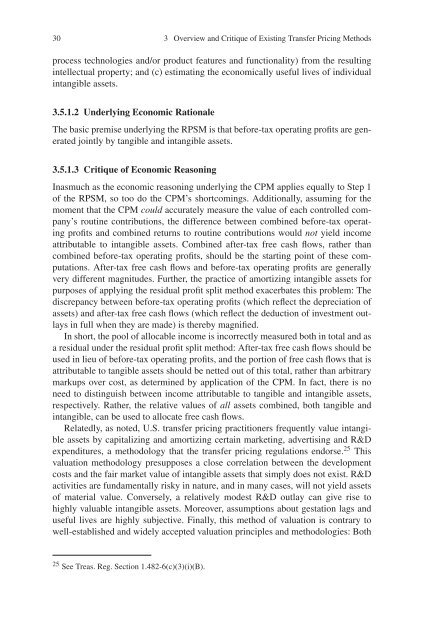Contents - AL-Tax
Contents - AL-Tax
Contents - AL-Tax
You also want an ePaper? Increase the reach of your titles
YUMPU automatically turns print PDFs into web optimized ePapers that Google loves.
30 3 Overview and Critique of Existing Transfer Pricing Methodsprocess technologies and/or product features and functionality) from the resultingintellectual property; and (c) estimating the economically useful lives of individualintangible assets.3.5.1.2 Underlying Economic RationaleThe basic premise underlying the RPSM is that before-tax operating profits are generatedjointly by tangible and intangible assets.3.5.1.3 Critique of Economic ReasoningInasmuch as the economic reasoning underlying the CPM applies equally to Step 1of the RPSM, so too do the CPM’s shortcomings. Additionally, assuming for themoment that the CPM could accurately measure the value of each controlled company’sroutine contributions, the difference between combined before-tax operatingprofits and combined returns to routine contributions would not yield incomeattributable to intangible assets. Combined after-tax free cash flows, rather thancombined before-tax operating profits, should be the starting point of these computations.After-tax free cash flows and before-tax operating profits are generallyvery different magnitudes. Further, the practice of amortizing intangible assets forpurposes of applying the residual profit split method exacerbates this problem: Thediscrepancy between before-tax operating profits (which reflect the depreciation ofassets) and after-tax free cash flows (which reflect the deduction of investment outlaysin full when they are made) is thereby magnified.In short, the pool of allocable income is incorrectly measured both in total and asa residual under the residual profit split method: After-tax free cash flows should beused in lieu of before-tax operating profits, and the portion of free cash flows that isattributable to tangible assets should be netted out of this total, rather than arbitrarymarkups over cost, as determined by application of the CPM. In fact, there is noneed to distinguish between income attributable to tangible and intangible assets,respectively. Rather, the relative values of all assets combined, both tangible andintangible, can be used to allocate free cash flows.Relatedly, as noted, U.S. transfer pricing practitioners frequently value intangibleassets by capitalizing and amortizing certain marketing, advertising and R&Dexpenditures, a methodology that the transfer pricing regulations endorse. 25 Thisvaluation methodology presupposes a close correlation between the developmentcosts and the fair market value of intangible assets that simply does not exist. R&Dactivities are fundamentally risky in nature, and in many cases, will not yield assetsof material value. Conversely, a relatively modest R&D outlay can give rise tohighly valuable intangible assets. Moreover, assumptions about gestation lags anduseful lives are highly subjective. Finally, this method of valuation is contrary towell-established and widely accepted valuation principles and methodologies: Both25 See Treas. Reg. Section 1.482-6(c)(3)(i)(B).
















